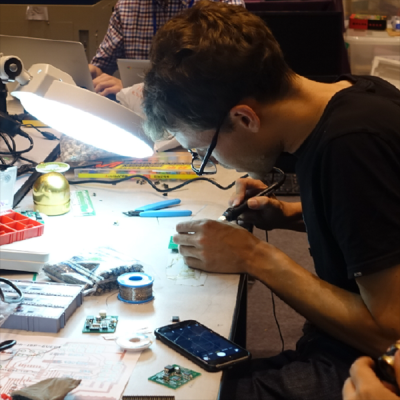Nadya Peek is one of the hackers that should require no introduction for the regular Hackaday reader. She is a postdoc at the Center for Bits and Atoms at the MIT Media Lab. She’s responsible for Popfab, a CNC machine that fits in a suitcase and one of the first implementations of a Core XY stage we’ve seen. Nadya has joined the ranks of Rudolf Diesel, Nikola Tesla, Mikhail Kalashnikov, and George W.G. Ferris by having a very tiny piece of the Novena laptop bear her name. She’s built cardboard CNC machines, and taken the idea of simple, easy to build printers, routers, and drawbots worldwide. She just defended her thesis, the gist of which is, ‘How to rapidly prototype rapid prototyping machines.’ She’s also one of this year’s Hackaday Prize judges, for which we have the utmost appreciation.
This year, the organizers of the Fab 12 conference on digital fabrication in Shenzhen turned to Nadya and her team to bring their amazing experience to conference attendees. A workshop was in order, but Nadya didn’t have time to organize the logistics. The conference organizers made a deal: the Center for Bits and Atoms would teach a workshop, but getting all the materials and electronics was the responsibility of the organizers.
Upon arriving at the Shenzhen Sheridan, Nadya found the organizers didn’t hold up their end of the bargain. The cardboard, motors, electronics, and glue were nowhere to be found. A “rider” doesn’t quite translate from English, it seems. This is Shenzhen, though, where you can buy all the cardboard, motors, electronics, and iPhone clones you could imagine. What was the solution to this problem? Founding a company in Shenzhen for eight days.
Half a tourist’s guide to Shenzhen and half a deconstruction of what goes into cardboard CNC, Nadya’s talk for the 2016 Hackaday SuperConference covers what happens when you have a week to build a company that will build machines that build machines.
Our Capabilities Are Your Possibilities
In Shenzhen, purchase orders and invoices are the domain of companies. To gather all the parts for this workshop conference, Nadya and the rest of the Bits and Atoms team founded a company, Gestalt Solutions Co. Ltd., with the motto, “Our Capabilities Are Your Possibilities”.
 With the company name in order, the team headed down to the Huaqiangbei marketplace, where they quickly snapped up a bunch of soldering irons, a reflow oven, and about $400 worth of assembly equipment. Orders were placed for four-layer PCBs, and stainless solder paste stencils. 3D printers and laser cutters at the conference were requisitioned, and electronic components were acquired.
With the company name in order, the team headed down to the Huaqiangbei marketplace, where they quickly snapped up a bunch of soldering irons, a reflow oven, and about $400 worth of assembly equipment. Orders were placed for four-layer PCBs, and stainless solder paste stencils. 3D printers and laser cutters at the conference were requisitioned, and electronic components were acquired.
Despite multiple problems, the conference went off without a (visible) hitch. All this, of course, was due to being at the only place on the planet where you can buy components to build assemblies to build robots that can build robots in three days… and having the skills to pull it off.
We’re pretty keen on engineering war stories, and there were plenty of them at the Hackaday SuperConference, but Nadya’s talk goes above and beyond what we usually hear. It’s something that could only happen in Shenzhen, and we’re glad she could make it out and reminisce about the bots of days past.

















WOW!!! Just WOW!!
I second that
So how long do you figure to fly into Shenzen and fly out in your own Iron man suit?
How to build a city that can build a lab that can build anything in 8 hours in 30years
Incredible !! I wish such embedded heavens are developed in many more countries !
How long to get affordable anti-gravity?
Hi Nadya, simon from Mediamatic times here. Why did you have to found a company? where there some local rules requiring this?
so wait why did they have to form a company?
I guess i’ll have to watch the hackaday © superconference ©™ to find out right
star simpson is on the list I guess they let her out of prison then
I don’t get the laptop thing either, did she make something for it? i don’t suppose tesla or the gun guy did because they are dead, or this guy just wrote her name on it for what reason? the link does not explain at all. if someone writes my name on their laptop can I do a conference?
“The brass nuts in the open area at the left constitute the Peek Array, a number of points on which users may attach expansion boards of their choice.” http://spectrum.ieee.org/consumer-electronics/portable-devices/novena-a-laptop-with-no-secrets
My guess (from some experience in Shenzhen myself) is that factories won’t answer the phone for you unless you’ve got a title and a company name behind your purchase order. One of the companies I worked for assigned all of us hardware engineers special “Shenzhen titles” to ensure we’d get prompt attention to our inquiries — hint: “director” is a key word. If you are “director of engineering for XYZ co” you get your emails returned. If you’ve got a cutesy silicon valley title like “head hacker” you’re going to be waking up to an empty inbox..
From NYC, you can fly direct to Hong Kong in about 16 hours, catch a train to Shenzhen. Including the border crossing, that’s maybe 2 hours. Do all your shopping in a day. I’m thinking in three days total you can have all the parts you need for whatever you want to build. Depending on your hourly rate, that’s got to be cheaper than paying hundreds for shipping, waiting for days (weeks?) for parts, and maybe not getting the right stuff.
border crossing queue will take >2 hours alone easily
I used to go to Shenzhen via HK in 2010 – I don’t remember it taking all that long. We used to take the boat across the harbor, iirc.
I cross the border all the time (I’m in shenzhen) the line is like 15 min; the max I have experienced was 30 min
And Nadya Peek’s name is so exalted that she doesn’t require HaD’s anti-ambiguity square brackets.
I really wanted to like this presentation, but it was just too disorganized and incoherent to be of use to me. Video summary: We had to scramble to get a project done. Shenzhen has resources to do this. :(
Nice job belittling what most understand is an impressive feat to pull off. It would be great if you would readjust your basis for making comments to help build up community rather than breaking it down like this.
There is a communication barrier — language, cultural, and technological — when working between the US and China. It’s not unique to this situation. What is unique is that they still pulled off the goal of the workshop.